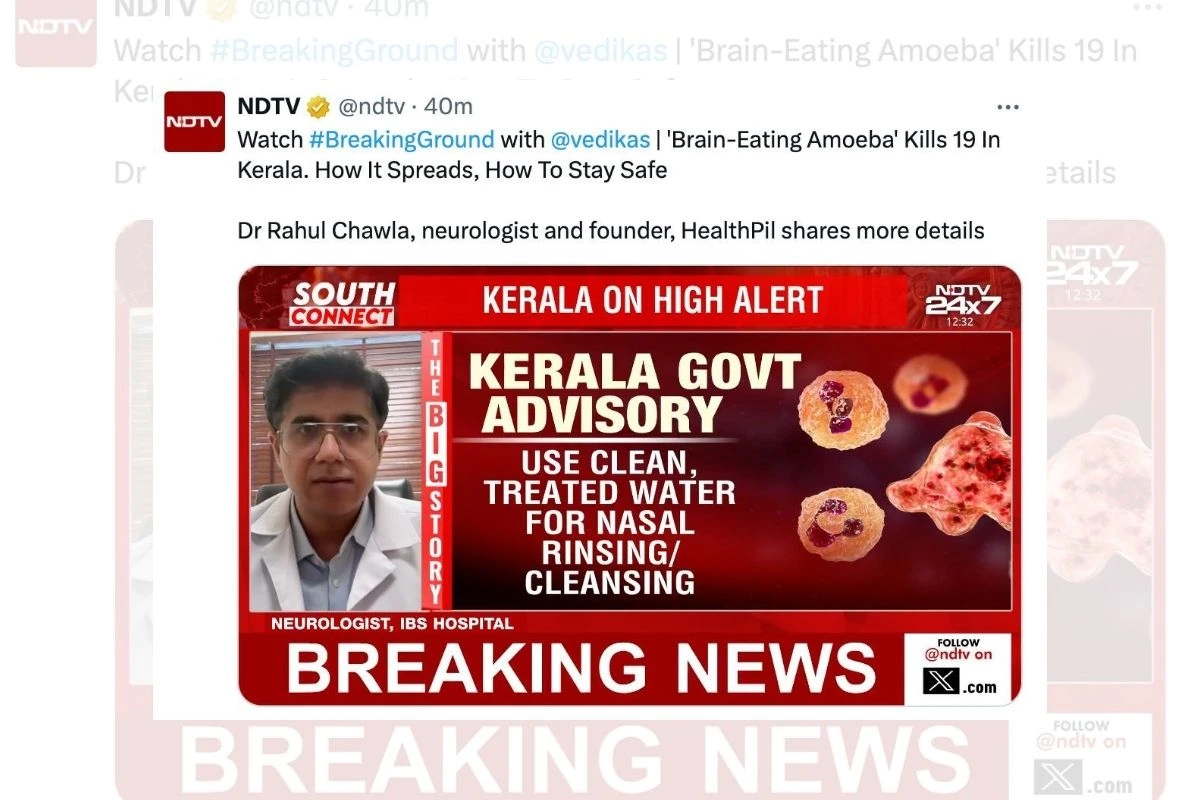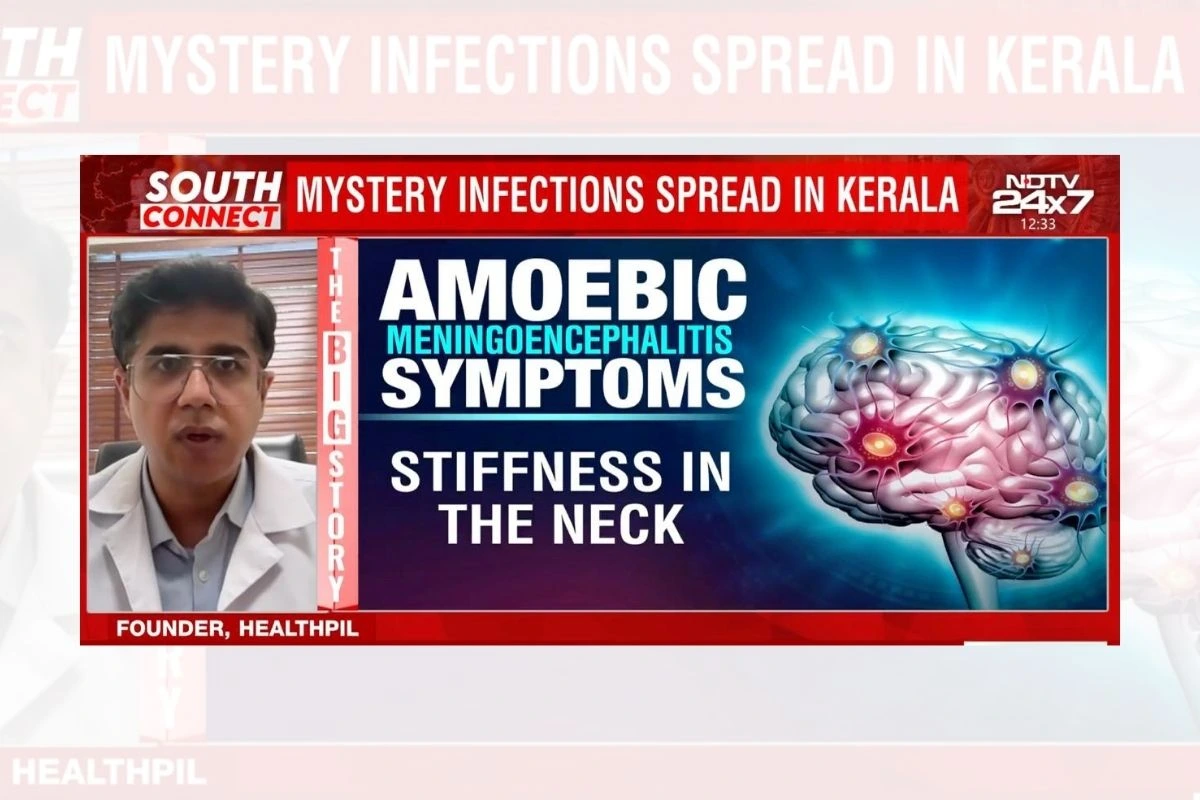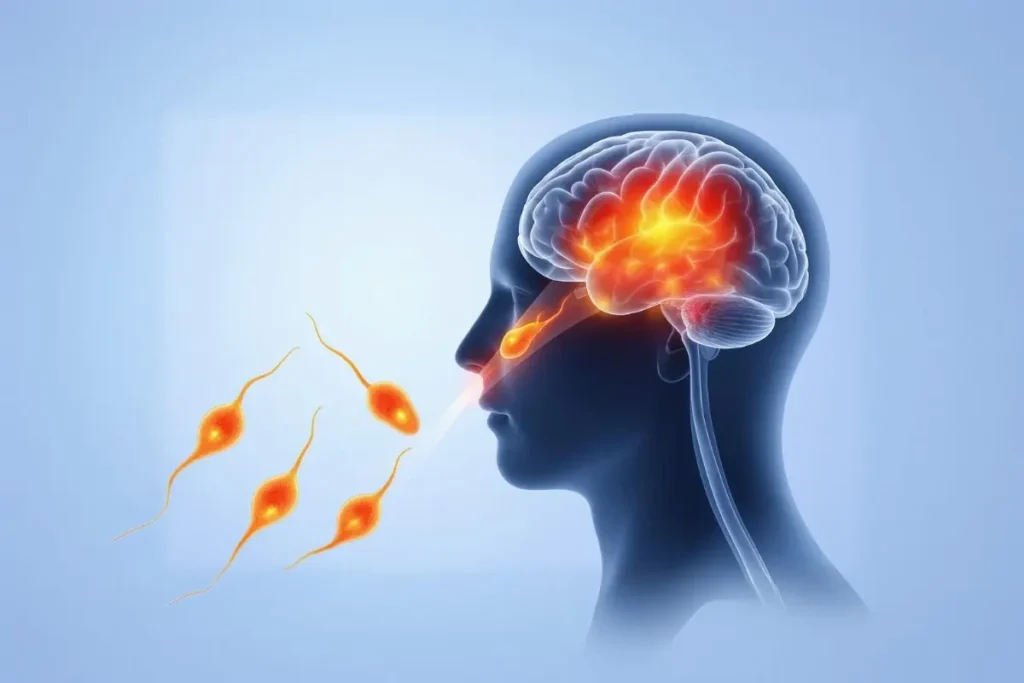Kerala has reported 19 deaths so far and 61 active cases of Primary Amoebic Meningoencephalitis (PAM), a rare but deadly brain infection caused by Naegleria fowleri, commonly known as the ‘brain-eating amoeba’. What makes the situation particularly alarming is how quickly the numbers have risen. Between 2016 and 2022, the state recorded just eight cases. But in 2023 alone, that figure shot up to 36 infections and nine deaths, and this year fresh cases are continuing to emerge.
Once considered extremely rare, the disease is now appearing in clusters, and the one question on everyone’s mind is: why is amoebic meningoencephalitis infecting people, and why is it being found so often in Kerala’s waters?
How Does Amoebic Meningoencephalitis Infect Humans?
The way this parasite enters the body is frighteningly simple. All it takes is for contaminated water to go up the nose, while swimming in ponds, splashing around during a bath, or even through certain traditional practices where water is sniffed in. From there, the amoeba travels through a thin plate of bone at the base of the skull known as the ‘cribriform plate’ and makes its way straight to the brain’s smell centre, called the olfactory bulb.
In a recent discussion with NDTV, Dr. Rahul Chawla, Neurologist in South Delhi and Founder of HealthPil, explained that “Naegleria fowleri specifically invades the Central Nervous System (CNS) through the nose. It is not transmitted through drinking water or the fecal-oral route, and importantly, there is no human-to-human transmission, which thankfully prevents an epidemic.”
Once inside, it doesn’t take long for the damage to begin. The organism multiplies rapidly, leading to swelling, inflammation, and severe injury to brain tissue. Most patients don’t even survive.
The first signs can look quite ordinary: a mild fever, headache, maybe some nausea. But within days, the illness can escalate to confusion, seizures or slipping into coma. By the time doctors realise what is happening, it is often too late.
Why Kerala Is Seeing More Cases of Amoebic Meningoencephalitis Now
Between 2016 and 2022, Kerala reported just eight cases of amoebic meningoencephalitis. But in 2023, the number shot up to 36 infections and nine deaths. In 2024 and 2025, clusters of cases have emerged again, something experts say is unusual for a disease once considered very rare.
Doctors point to three key reasons for this:
● Climate change: Kerala’s water bodies are warmer than before due to climate change. Naegleria, the amoeba responsible for this disease, thrives at higher temperatures, staying longer in its active, infectious stage.
● Contaminated water: Sewage discharge, animal waste, and poor sanitation enrich water with bacteria that amoebas feed on.
● Cultural practices: Rituals involving nasal cleansing or pouring untreated water into the nose increase direct exposure.
Dr. Rahul Chawla added: “The amoeba is typically found in stagnant sources of water, including ponds and poorly maintained swimming pools. It thrives mainly in tropical and subtropical climates like Kerala, where warmth and humidity provide the perfect environment.”

As Dr. TS Anish from Kerala’s Nipah Research Centre explained:
“Warmer waters not only make amoebas more infectious, but also suppress their natural predators and increase cyanobacteria, their food source. At the same time, people turn to ponds and streams to cool off, creating the perfect storm for infection.”
Who Is at Risk?
According to Dr. Rahul Chawla: “Anyone who is immunocompromised has a higher chance of contracting this infection. Men and children are more commonly affected, especially those who swim in untreated freshwater bodies or work in stagnant water sources.”
This explains why more cases are being reported in working-age men and children in Kerala.
Signs and Symptoms of Amoebic Meningoencephalitis
Though rare, amoebic meningoencephalitis progresses alarmingly fast. Watch out for:
● Severe headache and fever after swimming or bathing in untreated water
● Stiff neck, nausea, or vomiting
● Sudden confusion, drowsiness, or seizures
If any of these appear after freshwater exposure, seek emergency care immediately.
Can Amoebic Meningoencephalitis Be Treated?
Unfortunately, effective treatments are limited. Fewer than 10 cases are reported in India each year, hence making clinical trials almost impossible. But, drugs like amphotericin B and miltefosine are sometimes tried, though survival rates remain very low. Prevention, therefore, is the only better way at the moment.
Dr. Rahul Chawla emphasises,
“Amoebic meningoencephalitis is an extremely rare but fatal brain infection. Globally, over 95% of patients die despite treatment, making it one of the deadliest CNS infections known. The presentation is abrupt, with high fever, headache, vomiting, and rapid neurological decline.

Although there is no 100% effective treatment – IV Amphotericin and Miltefosine have been tried successfully in some cases.”
What You Can Do to Protect Yourself from ‘Brain-Eating Amoeba’?
● Avoid swimming or bathing in stagnant, untreated freshwater, especially ponds and poorly maintained pools.
● Do not let water enter your nose during rituals or recreational activities. Use boiled, cooled, or chlorinated water if nasal cleansing is part of your routine.
● Support water safety efforts in your community. Chlorination of wells and ponds, sewage management, and clean-up drives are proven ways to reduce risk.
Why Kerala’s Outbreak Is a Warning Sign
Naegleria fowleri is not new, it exists in soil and water worldwide. But Kerala’s outbreak highlights a larger issue, that is, unsafe water. As long as climate change warms rivers and ponds, and sanitation remains unchecked, the risks will continue to persist.
This is not just about amoebas, unsafe water also spreads hepatitis, diarrheal diseases, and other brain infections. So, experts stress that only a coordinated “One Health” approach; linking health, sanitation, animal husbandry, and local governance, can help keep our water bodies safe.
How HealthPil Can Help
If you or your loved ones are worried about fevers, unexplained headaches, or neurological symptoms after water exposure, don’t ignore them. HealthPil connects you to trusted neurologists and infectious disease specialists who can guide you on urgent care, preventive measures, and follow-up.
We also offer:
● Second opinions if you’re unsure about a diagnosis
● Preventive health check-ups to rule out infections and neurological risks
● Doctor consultations from home
Disclaimer
This article is for informational purposes only and does not replace medical advice. Amoebic meningoencephalitis is a medical emergency. If you or someone you know develops sudden fever, headache, or neurological symptoms after freshwater exposure, seek immediate medical attention.

